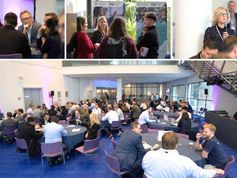Change the system to change the patterns
Emma Fromberg, Course Director at the University of Cambridge Institute for Sustainability Leadership reflects on how the circular economy movement can learn from designers’ unique approach to complexity.

When sports-brand Adidas introduced their sustainability-line, they announced: “This is bigger than sport, this is our future”. Their new line, however, consists of near-identical items as their regular, unsustainable line. This main difference is that this line consists of garments and footwear made from a humble amount of 50% ocean plastics.
Through a story about saving our precious marine wildlife, they designed these products to sell more of them – now available with less guilt. At the end of use, these designs will still end up on the same landfills and in the same incinerators as so-called linear or unsustainable products and may even pollute the oceans once again. The scale (bigger than sport) that they identify in their tagline, is not reflected in a bold and brave design that aims to addressing the linear system in which it exists. They merely attempted to replace a “pattern” from within the linear system with another pattern: an undesirable behaviour characteristic of the system structures that produce them.
Circular economy challenges are complex Even though the breadth of the circular economy agenda demonstrates the complex and interconnected nature of its challenges, some businesses still decide to only focus on a single behaviour change, product, or material flow. They decide to replace one linear pattern for a more “circular” one, without addressing the system that generates these linear patterns. Some parts of the circular economy debate seem to have lost crucial elements around systems thinking and have started to put more emphasis on churning out these circular products instead of linear ones.
This approach ignores the underlying system and puts an unrealistic expectation on the role of design and designers. It is naïve to think that only circular product design will be the band-aid on the linear economy that we need right now. Instead of blaming designers for their current involvement in the extractive aspects of a linear economy, we could start learning from their unique approach to complexity and empower them to shape and nudge the systems that we need to redesign the economics underpinning our current linear system.
The importance of product design is often emphasised when addressing material flows in a circular economy. Of course, through products and services, we can all be intrigued and inspired about what the idea of a circular economy has to offer. However, instead of focusing on circular design (the patterns) it would be more productive to focus on the circular economy (the system that generates the patterns).
Waste is not just design gone wrong. Waste is an entire system of production and consumption gone wrong. Therefore, a more useful reaction to the challenges around waste is to look at the entire value chain instead of only to the design of the product.
Having a broader perspective on waste creation, through the lens of a value chain, will reveal how complex these issues are. Besides that, it will also demonstrate that most agency is not with the designer but in other places within the value chain – starting with the person who briefs the designer.

Lessons from design
Yet, there may be a valuable lesson hidden in perhaps one of the most unsustainable movements within the design community: Human-Centred Design (HCD): a design approach that evolves around meeting human needs. HCD fails to acknowledge context sufficiently, since the priority is the human that the product is designed for. It underappreciates the fact that a product is produced, used and disposed and does not exist in a vacuum.
Designers that are proponents of HCD are often mostly interested in understanding human needs and the complexities of human behaviour which can be irrational, directed by what is fashion at the time and may be highly cultural and contextual. Humans are also incredibly diverse: what works for one, doesn’t work for the other. Desires and needs may transform over time, sometimes abruptly and unexpectedly. The task of the designer is to react to this complex and dynamic behaviour.
These designers have mastered the art of making quick trade-offs and elegantly navigating dilemmas in these complex situations when time is scarce. To learn from their approach, one must understand the iterative nature of the design process. First, a designer is presented with a design problem or opportunity.
Their initial reflex is to start understanding the problem better before jumping to solutions. They start obtaining information: through (user) observations, literature research and through many other ways, they start to understand the system in which the problem exists. Most of this type of information can be described as “organised simplicity” as Gerald Weinberg noted in Figure 1. This is followed by a phase of synthesis and results in basic solution: an idea.
They make this into an even more simplified prototype and test specific aspects of this idea. By presenting this to a potential user and carefully observing the interaction between prototype and user, they obtain relevant information about complex human behaviour that will help them move forward in the design process. This phase reveals aspects of organised complexity. This process will last for many cycles, oscillating between organised simplicity and organised complexity. We call this an iterative approach.

The impact of interactions Using this iterative approach in a thoughtful way may be a key element when intervening on systemic level – such as in the transition to a circular economy. To appreciate the role of making these iterations and listening to feedback from the system, we could look at changing a ball game, for example: football. In football, there are two teams consisting of each eleven players and they are only allowed to kick the ball with their feet.
Now look at the linear economy: fossil fuel is subsidised, labour is expensive, society believes success is achieved through hard work only, large-scale business operations are preferred over small-scale niched businesses, etc. These systems conditions generate their own patterns. In football it might be dramatic tackles and in the linear economy it might be the not-so-sustainable ocean plastic collection from Adidas. If we want to shift from playing football to another game, we do not just simply change the players in the field and keep all the rules the same. We start by changing the rules.
We can start with adding extra balls to the game or changing the size of the ball. Perhaps players are only allowed to use their hands in this new game instead of feet. Through testing and making iterations, one can slowly start to understand the implications of the change in rules and continue to make more incremental changes until the game works and is exciting to watch again. Tim Brown, Former CEO of design-consultancy IDEO, presented the idea of a “systems leadership” in his article called “Intervene, don’t overthink”. He explains the importance of influencing on a systems level and why designers are so well placed for this:
“The complexity of systems makes it tempting to over-design at the outset. The traditional approach to regulatory policy design is a case in point. Lengthy study followed by detailed proposals that seek to account for as many future scenarios as possible results in slow, unwieldy and rigid regulations that are often unsuited to the fast-paced development of the technologies they are supposed to regulate.”
Superblocks
One of the most illustrative and bold examples of intervening on a system-level must be from Salvador Rueda, head of the Urban Ecology Agency of Barcelona. It was Rueda who is the visionary behind the design of Superblocks – transforming a city into sustainable and connected neighbourhoods. Initially aimed towards addressing noise pollution in the city, Barcelona decided to implement the first Superblock in 1993 by locking out traffic from one of its neighbourhoods. The second and third Superblock got built in 2003 in the neighbourhood Gracia, where they also eliminated one-way streets for cars and removed the raised sidewalk. All means of travel share equal access now.
He continued his journey and got involved in a project for the Poblenou Superblock which also incorporated elements to enhance the social capital in the area such as picknick tables, a permanent playground, green areas which brought the residents - mainly consisting of young families – closer together. If the plan is completed in its entirety, there could be 500 more Superblocks lined up in the future – not only addressing the city-wide noise pollution but also enhancing social capital, celebrating small businesses and community-led initiatives.
Rueda could have simply lowered the speed limit in 1993 to cancel out the noise pollution from cars, but he didn’t. He moved beyond merely changing the one pattern he was tasked to change. Rueda followed his curiosity and looked at the system in which this noise is created – and explored this through multiple generations of Superblocks. By addressing the system as a whole, the positive consequences of his ideas go beyond mitigating noise pollution and have medical, psychological, social and environmental benefits built in. These holistic solutions may over time cause an even more profound cultural or even political change.

The role of designer when transitioning to a circular economy
Asking designers to design us better products without changing the economy is simply not ambitious enough. If we want to achieve genuine circularity, on an economic, social and environmental level, we need to learn from designers and empower and involve them to shape the system of a circular economy. Changing “the rules of the game” requires a certain comfort with navigating complexity and acknowledging not knowing everything from the outset.
Designers may help to bring in a valuable perspective on when to slow down and take time to understand the implications of changing “the rules” and when to stimulate more rapid change in a thoughtful way. Only through changing this wider system and listening to its feedback, we shall change the patterns that are generated by the system and eliminate the economic, social and environmental problems that we currently encounter.
Acknowledgements
I would like to acknowledge the important conversations and feedback from Ken Webster and Kinge Gardien.
Further Reading
Meadows, D. H. (2008). Thinking in systems: A primer. Chelsea Green Publishing.
Webster, K. (2021). A circular economy is about the economy. Circular Economy and Sustainability, 1-12.






Yorumlar